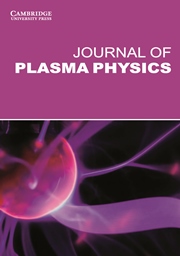Article contents
The scaling of reconnection rate in the two-fluid model of a collisionless forced magnetic reconnection
Published online by Cambridge University Press: 16 January 2013
Abstract
The two-fluid model of collisionless forced magnetic reconnection is considered where breaking the frozen-in flow constraint for magnetic field lines is provided by electron inertia. Following the Taylor problem, a tearing stable slab of plasma with a magnetic field reversal is subjected to a small-amplitude boundary perturbation that drives magnetic reconnection at the neutral surface within the plasma. It has been shown that unlike the resistive regime, where the two-fluid magnetohydrodynamics (MHD) description reduces to the single-fluid MHD regime at sufficiently small values of the ion inertial skin-depth, di ≡ c/ωpi (with ωpi as the ion plasma frequency), there is no room for the single-fluid MHD reconnection in the collisionless case, even at very small values of di. Meanwhile, contradictory to the resistive reconnection, the rate of collisionless Hall reconnection always decreases with time as reconnection proceeds. In particular, in the main stage of Hall reconnection, when transition between two main equilibria states are taking place, it scales as t−1/2.
Information
- Type
- Papers
- Information
- Copyright
- Copyright © Cambridge University Press 2013
References
- 3
- Cited by

